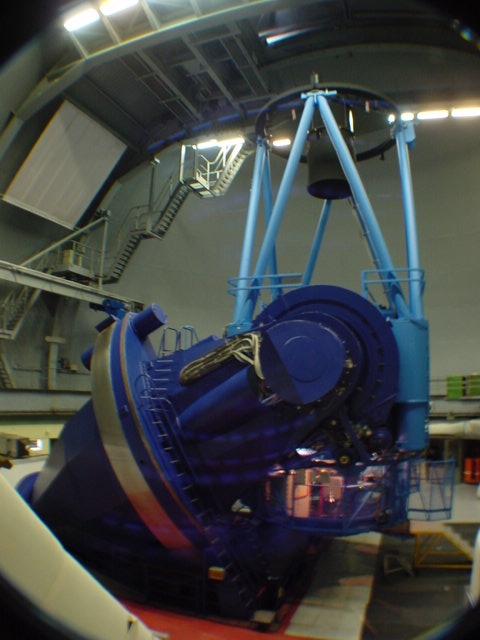The ESO 3.6m Telescope
Summary
The ESO 3.6m Telescope was commissioned in 1977, and completely upgraded in 1999. In 2004 a new secondary mirror cell was manufactured, improving considerably the image quality of the telescope. In 2007 the control system of the lateral pads was upgraded. The image quality of the telescope is better than 0.2 arcsec at Zenith. The telescope has a horseshoe/fork mounting, and an interchangeable top unit allowing the secondary mirror to be changed from a F/8 to a F/35 Cassegrain focus. The pointing error is about 5 arcsec RMS. The pointing is limited to 70 deg. zenithal distance, and 5.5h HA, but a small region under the pole is reachable. Operation and maintenance of the telescope is the responsibility of ESO.
Since April 2008 HARPS, using the F/8 Cassegrain focus, is the only instrument available at the 3.6m.
The telescope is at a geographical location of 70.7345W, 29.2584S, and an altitude of 2400 metres above sea level.
Current Instruments
The ESO 3.6m telescope host the following instrument:
- HARPS: The High Accuracy Radial velocity Planet Searcher at the ESO La Silla 3.6m telescope is dedicated to the discovery of extrasolar planets. It is a fibre-fed high-resolution cross-dispersed echelle spectrograph.
- NIRPS: The Near Infra-Red Planet Searcher at the ESO La Silla 3.6m telescope is dedicated to the discovery and characterization of extrasolar planets. It is a fibre-fed high-resolution cross-dispersed echelle spectrograph in the near infrared.
Decommissioned Instruments
- CES: A spectrograph providing a resolving power of up to 235,000 in the 346 - 1028 nm region.
- EFOSC2: The ESO Faint Object Spectrograph and Camera (v.2) to give its full name, is a very versatile instrument for low resolution spectroscopy and imaging.
- TIMMI-2 Thermal Infrared MultiMode Instrument dedicated to the 3 micron to 25 micron
Content of these Pages
The following items are available on the 3.6m Telescope pages, using the bar on the left.
- Telescope Overview: General Information about the telescope
- Information for Observers
- Telescope Operations (internal)

